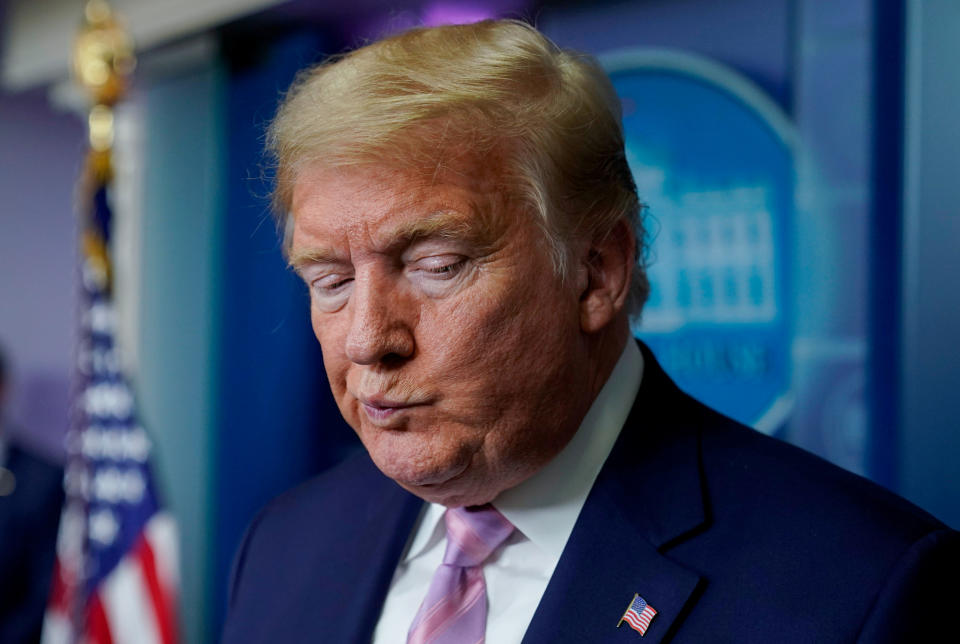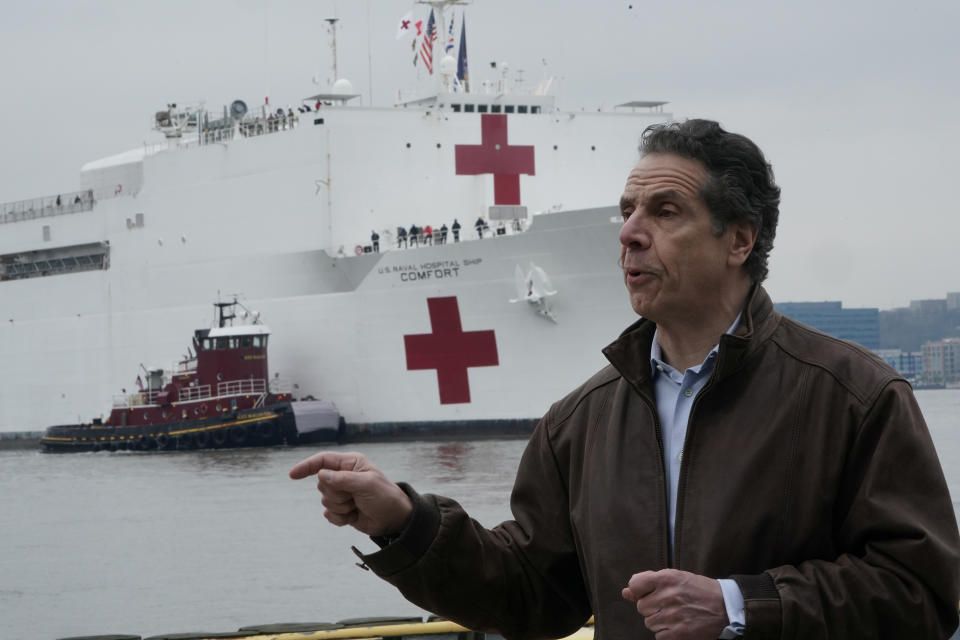When will the coronavirus lockdown end? Trump says the only 'metrics' that matter are in his head. Governors say otherwise.
How will we know when it’s time to “reopen America”? So far pretty much every U.S. official with any real authority seems to agree: not yet.
This group has included President Trump, who initially urged an Easter drawdown of social-distancing measures, then backtracked when virus models indicated that hundreds of thousands of Americans were projected to die from the coronavirus even if lockdown orders remained in place.
But now the president is again itching to get back to business, citing May 1 as his new target. “Without question, it’s the biggest decision I’ve ever had to make,” Trump said Friday. “I want to get it open as soon as we can. We have to get our country open.”
On Monday, Trump promised on Twitter that “a decision by me, in conjunction with the Governors and input from others, will be made shortly!”
It’s still unclear, though, how he will make that decision. Asked Friday which “metrics” he will use to judge when the country can return to some semblance of normal, Trump pointed to his head.
“The metrics right here,” he said. “That’s my metrics. That’s all I can do.”

Trump’s inability to name any specific benchmarks suggests, as Politico reported Sunday, that the “White House still has no road map for restarting the economy” because “internal competition, a lack of communication and a shortage of coronavirus testing are complicating President Donald Trump’s May 1 goal.”
It’s unlikely, meanwhile, that Trump has the legal authority to reopen the entire country on whatever timetable he wants — despite the fight he has been picking with the states and his assertion that “when somebody is the president of the United States, the authority is total.”
And so beyond the White House, governors such as Gavin Newsom of California and Andrew Cuomo of New York — fearing that Trump may jump the gun, with little more than his political instincts to guide him — are starting to announce their own metrics.
Such efforts could point the way toward a more cohesive and data-driven national approach.
On Tuesday, Newsom announced his framework for easing California out of its stay-at-home order. “The West Coast is guided by science,” Newsom tweeted Monday, touting a new West Coast pact with Oregon and Washington state to develop shared regional protocols for reopening. “We issued stay at home orders early to keep the public healthy. We’ll open our economies with that same guiding principle.”
Newsom’s framework for transitioning “from surge to suppression, and ultimately to herd immunity and a vaccine” is focused on California’s ability to do six things: (1) Expand testing to appropriately tracing and tracking exposed or infected residents; (2) Protect the state’s most vulnerable populations, including seniors; (3) Prepare the hospital system to address additional surges; (4) Partner with public and private entities to develop coronavirus therapeutics to meet future demand; (5) Ensure that schools, businesses and other facilities can support physical distancing; and (6) Have a system in place to reinstitute stay-at-home measures if necessary.
“There’s no light switch here,” Newsom said. “I would argue it’s more like a dimmer ... toggling back and forth between less restrictive and more restrictive measures.”
To determine when this next phase — “the hardest phase of all,” in Newsom’s words — might begin, the governor and his teams will be watching two metrics in particular: overall coronavirus hospitalizations and total intensive-care (ICU) hospitalizations.
“We want to see hospitalization numbers flatten and start to decline, and we want to see ICU numbers flatten and start to decline,” Newsom said. “If we see that over the course of a few weeks, and commensurate with that we build this infrastructure … in those six key categories,” then California can initiate “a loosening of these stay-at-home orders in a precise and targeted and gradual way, where we’re using data, using science, using real examples on a daily basis in order to iterate and again to toggle that dimmer so we get exactly the appropriate lighting … and get this economy roaring again.”
Newsom went on to announce that California’s total number of ICU coronavirus hospitalizations had “actually declined modestly” — by 0.1 percent — since Monday to 1,177. Coupled with a “modest increase” of 3.6 percent in the overall hospitalization numbers as well as numbers of suspected coronavirus hospitalizations that have also “started to come down,” the data suggested both a “light at the end of the tunnel” and a “sober” recognition that “we are not out of the woods yet.”
“We are not spiking the ball,” Newson continued. But “this cannot be a permanent state. And I want you to know it’s not.”
A similar strategy is taking shape on the East Coast too. “Any plan to reopen society MUST be driven by data and experts, not opinion and politics,” New York Gov. Andrew Cuomo tweeted Monday — the same day he unveiled a parallel regional pact with New Jersey, Connecticut, Pennsylvania, Delaware, Rhode Island and Massachusetts. “We will learn from the warning signs from other countries. We will take every precaution. We will work together as a region.”
The eastern states have yet to unveil the specific metrics that will drive their decision-making. But on Monday the Health Department of New York City — the epicenter of the U.S. outbreak, with more than 200,000 cases and 10,000 deaths — revealed that it is “closely monitoring” three key “indicators” to determine “when certain social (physical) distancing restrictions will be lifted for people who are not at high risk for serious complications of COVID-19.”
“They were getting increasing questions about when we’re going to start reopening, and they smartly felt like they wanted to make this an objective conversation and ensure that people look at the data,” New York City Council Member Mark D. Levine, the chair of the council’s health committee, told Yahoo News.
“And that’s why they put this out there: so the public can watch our progress and understand why public health experts are saying we’re not there yet — or why, eventually, we are. We need to have clear data to explain those decisions.”
The first indicator is the daily number of people admitted to NYC hospitals for influenza-like illness and pneumonia. Note that it’s not “the daily number of people admitted to NYC hospitals for coronavirus.” There’s a good reason for that: By subsuming coronavirus patients within the larger category of influenza-like hospitalizations, NYC can compare data across time.
In previous years, NYC’s average mid-April rate of flulike hospital admissions was about 100 per day. On April 3, however, that number hit 672. It’s been steadily falling since then — the number on April 12 was 326 — but the Health Department says it wants to see it stay below 200 for 10 consecutive days.
Given hospital capacity and historical data, that milestone would represent a manageable level of spread.
“That’s double the normal number, so it’s still a lot,” Levine explains. “But the goal is to get this down to a manageable number of cases where we can use mass testing, contact tracing and quarantine to contain it.
“It’s impossible now because we have so many thousands of new cases each day. But if we can get down to a few hundred new cases a day, and not all of them will need medical care, then the public-health authorities feel like this would be manageable through a containment strategy and we could start to return to normal life.”

NYC’s second indicator is the percentage of local coronavirus tests that come back positive. Right now, this one is nowhere near where it needs to be. Over the past week, about 60 percent of the people getting tested across the city have come back positive; at the city’s Public Health Laboratory, where patients must experience severe symptoms to get a test, that number has hovered around 80 percent.
The Health Department wants to see the citywide number stay below 15 percent — and the Public Health Laboratory number stay below 30 percent — for 10 consecutive days.
“Right now in New York City hospitals, essentially everybody has COVID-19,” Levine says. “Someone who’s a car crash victim comes in, they do a chest X-ray and there’s the clear signs of coronavirus. It’s everywhere. And so as that percentage starts to drop, it’s going to indicate something like a return to normalcy in the health care system — that we’re starting to be able to serve people who aren’t coronavirus victims.
“We do want to not confuse the fact that we may be plateauing with the fact that we’ve plateaued at a level of an extremely intense number of acute patients in the hospital. Hospitals still feel like they’re under siege.”
Finally, New York’s third indicator is the daily number of people in critical care at NYC Health + Hospitals, the city’s public hospital authority.
On April 11, Cuomo touted the fact that the number of New York patients in intensive care had fallen (slightly) for the first time since the outbreak began. But the Health Department’s data shows that it’s too early to call this a trend; at acute sites, the number fell by 22 patients between April 10 and 11, then rose by 15 to 850 patients between April 11 and 12. Authorities have not yet determined a milestone that will “reflect a sustainable critical volume,” but they plan to release one soon.
Taken together, these data-driven benchmarks suggest that New York City still has a long way to go before it can start reopening. And Levine cautions that even when the city hits these milestones, social-distancing measures won’t automatically cease.
“We would need to have surveillance testing, contact tracing and quarantine capacity in place as well,” Levine says. “Those are essential for a return to normal life. These numbers are simply our way of knowing when we’re truly past the apex and when it’s going to be safe to begin thinking about reopening. We can’t do it prematurely.”
Asked how he feels about Trump’s talk of reopening next month, Levine says he’s “terrified.”
“Absolutely terrified,” he continues. “The thought that we could be ready to open on May 1? There’s just nothing in the data to indicate that.”
_____
Click here for the latest coronavirus news and updates. According to experts, people over 60 and those who are immunocompromised continue to be the most at risk. If you have questions, please refer to the CDC’s and WHO’s resource guides.
Read more:





